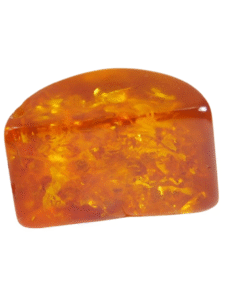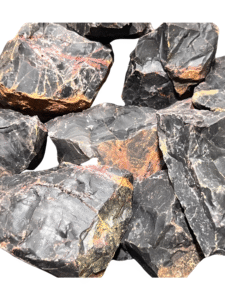When you explore the world of gemstones, you may come across onyx and amber, two beautiful stones that could not look more different. One is a deep, rich crystal, the other a glowing gem formed naturally over ages. You may notice their color, shape, and finish can vary greatly. Some display rare inclusions while others shine like glass. In this guide, let’s compare each stone’s physical property, form, and light display to help you identify and enjoy these natural products.
Onyx vs amber metaphysical properties
| Property | Onyx | Amber |
|---|---|---|
| Emotional connection | You might feel that onyx could help you stay steady when life feels full of change or challenge. It may serve as a stone that promotes a sense of grounded presence. | You may sense that amber helps lift your spirit and brings a sense of lightness. It could promote feelings of warmth and comfort through its gentle energy. |
| Stress and calm | You may turn to onyx when seeking calm during moments of stress. Its steady energy may help you feel a little more composed even when your thoughts feel scattered. | Amber could help you let go of worries that weigh you down. Holding it might bring a sense of ease that allows you to release tension and feel lighter. |
| Confidence and strength | If you are needing to feel stronger in your decisions, onyx may serve as a stone that supports inner strength and a sense of quiet confidence. | Amber might encourage you to trust in your natural self. Its bright energy could help you feel more open and connected to your own inner worth. |
| Energy flow | Some believe that onyx could help slow scattered energy and bring it into a steady flow, keeping you from feeling overstretched or drained. | You may find that amber helps energy flow more freely, bringing a light and vibrant quality that feels refreshing and uplifting. |
| Personal growth | Onyx may help you stay centered when working through personal growth, keeping you connected to the lessons you are learning without losing balance. | Amber might spark curiosity and a sense of renewal. It could support personal growth by bringing fresh perspectives and positive feelings to your path. |
| Emotional healing | You might use onyx to support emotional healing through stability. It could help create a space where you can process feelings with clarity. | Amber may bring comfort when you are healing emotionally. Holding it could remind you of the warmth that still exists even through difficult times. |
| Protection | You may carry onyx when you wish to feel protected from negative energy. Its grounding presence may help you stay aware and strong in any space. | Amber could offer a sense of shielding through light and warmth. Many people feel that its bright nature supports a positive environment around them. |
| Mental clarity | Onyx might help clear away mental fog. You may find that its grounding qualities help you focus and see things with greater clarity. | Amber could help bring light to your thoughts, making it easier to see possibilities and ideas that had seemed hidden before. |
| Connection to the earth | You may feel a stronger connection to the earth when holding onyx. Its deep tones and solid feel could remind you of the strength found in nature. | Amber may connect you to nature through its ancient origin. Holding it could help you feel linked to the natural world and its ongoing cycles. |
| Mood and positivity | Onyx may bring a sense of calm and steadiness that supports a more balanced mood over time. You might find that it helps smooth emotional ups and downs. | Amber could help lift your mood with its bright and sunny energy. You may find that it brings joy and a sense of renewed lightness when you need it most. |

Onyx vs amber physical properties
| Property | Onyx | Amber |
|---|---|---|
| Appearance | You will see that onyx often shows solid black or black with white bands, giving it a striking and bold look. The surface is smooth and may have a glass-like finish when polished. | You will notice that amber can range from golden yellow to deep orange or even reddish brown. Its surface feels warm and smooth, sometimes containing trapped bubbles or ancient plant matter. |
| Luster | You might find that onyx has a waxy to vitreous luster, which makes it reflect light in a crisp yet soft manner, especially after it has been polished. | You could observe that amber usually displays a resinous luster, giving it a subtle glow that looks almost soft and sometimes slightly matte rather than sharp or glossy. |
| Transparency | When you look at onyx, you will see that it is typically opaque, which means no light will pass through it at all. Even when thinly cut, it stays dark and solid. | With amber, you may notice that it can range from completely transparent to translucent. Light often passes through parts of it, giving it a glowing and sometimes layered appearance. |
| Hardness (Mohs scale) | Onyx tends to fall around 6.5 to 7 on the Mohs hardness scale, meaning it could handle daily wear without scratching easily but is not as hard as stones like quartz. | Amber ranks much lower at around 2 to 2.5 on the Mohs scale. This means it is quite soft, and you might scratch or dent it with just a fingernail or light pressure. |
| Density | When you hold onyx, it will feel heavier than it looks because its density ranges from about 2.55 to 2.70 grams per cubic centimeter. It carries a solid weight in your hand. | Amber feels surprisingly light, as its density is around 1.05 to 1.10 grams per cubic centimeter. You may even find that it can float in saltwater because of this low density. |
| Fracture | If broken, onyx will show a conchoidal or uneven fracture, so the break will look curved and glassy or jagged rather than straight or clean. | Amber, when broken, tends to show a conchoidal fracture as well, but you may also find the edges somewhat crumbly or rough because of its softer nature. |
| Cleavage | You will see that onyx lacks true cleavage, meaning it does not break along flat, even planes but instead fractures irregularly when enough force is applied. | You will also find that amber does not show true cleavage. Instead, it breaks in a way that follows its natural resin flow, which leads to irregular and curved surfaces. |
| Streak | If you were to rub onyx on a streak plate, you would usually get a white streak, no matter what color the onyx appears to be on the outside. | When amber is tested on a streak plate, it tends to leave little or no streak at all. The plate may stay clean or show a faint powder depending on how much pressure is used. |
| Temperature feel | When touched, onyx typically feels cool because it conducts heat slowly. It will stay cool in your hand for a long time before warming up slightly. | Amber often feels warm to the touch because it is an organic resin with low thermal conductivity. It warms quickly in your hand and feels soft compared to stone materials. |
| Electrical properties | You will find that onyx does not build up static electricity when rubbed. It remains electrically neutral under normal conditions. | Amber can build static electricity when rubbed with a cloth. You might see it attract small bits of paper or hair after you give it a good rub. |

Onyx vs amber color
| Aspect | Onyx | Amber |
|---|---|---|
| Primary colors | When you look at onyx, you often see deep black as its most well-known color. Sometimes it can also show bands of white, cream, or brown running through the black base. | You will find that amber most commonly appears in shades of yellow, golden orange, honey, and sometimes deep reddish brown. The tones often look warm and rich. |
| Color variations | You may discover that onyx comes in a few other shades such as green, red, or brown, though these are usually dyed or treated. The natural banded black and white version remains the most familiar. | Amber can display a wide range of tones from pale yellow to deep cognac. Some rare pieces may even appear in shades of green or bluish hues under certain lighting. |
| Appearance in light | Onyx generally stays dark under all lighting. Its black tones remain deep and rich, though polished surfaces may reflect a subtle shine or highlight any banding present. | Amber may change its appearance slightly depending on light. It could seem brighter and more glowing under sunlight while appearing softer and deeper under indoor lighting. |
| Uniformity | Onyx tends to display a very solid and even color if pure black. When banded, the contrast between light and dark bands is usually sharp and well-defined. | Amber often shows natural variations and inclusions that create unique patterns and areas of transparency. Each piece may look different even within the same color family. |
| Translucency impact | Onyx is typically opaque so the richness of its color remains uniform and strong. The color does not shift with light passing through since it usually will not allow light through. | Because amber can be translucent or even transparent, the depth and vibrancy of its color may change depending on how light interacts with the stone from different angles. |

